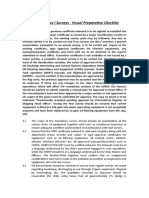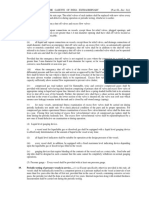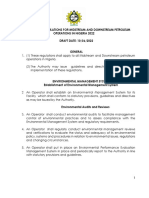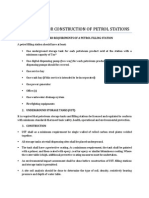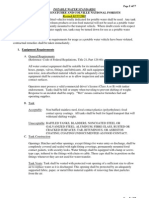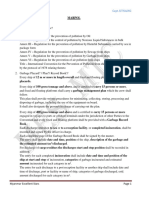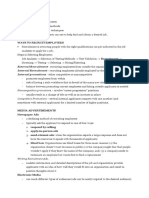Regulation Fuel-Chemical Storage Tank Installation
Regulation Fuel-Chemical Storage Tank Installation
Uploaded by
Arun HarshanCopyright:
Available Formats
Regulation Fuel-Chemical Storage Tank Installation
Regulation Fuel-Chemical Storage Tank Installation
Uploaded by
Arun HarshanOriginal Title
Copyright
Available Formats
Share this document
Did you find this document useful?
Is this content inappropriate?
Copyright:
Available Formats
Regulation Fuel-Chemical Storage Tank Installation
Regulation Fuel-Chemical Storage Tank Installation
Uploaded by
Arun HarshanCopyright:
Available Formats
Regulation DD-18.
0: Fuel/Chemical Storage Tank Installation
18.1 Detailed engineering drawings for Fuel Storage tanks for all type of installations including under
ground, above ground, within or outside the building with storage tank capacity, location, piping,
distribution, filling, gauzing and safe distances from the nearest building/property line and safety
provisions etc. shall be submitted to obtain prior approval before the construction/installation.
18.2 All FRP/GRP/Plastic underground tanks shall be encased with concrete encasement. A proper leak
detection system shall be installed to detect any leakage.
18.3 A minimum 2 mm thick HDPE liner shall be installed at the bottom of chemical/fuel/wastewater tanks
to prevent leaks and EHS shall be invited for inspection after the same is laid (During construction).
18.4 For chemical/oils tanks, concrete bund wall shall be provided. Bund wall calculation with 110%
capacity of the largest tank, considering the free volume available after deduction of submerged
tanks volume/piping/civil works in the bunded area.
18.5 All pipe lines shall be marked and color coded and shall be checked during the inspection.
18.6 The tank design & installation shall meet the requirement laid down in API (American Petroleum
Institute) and NFPA 30. The design verification report from third party consultant shall be submitted
to EHS.
18.7 Wherever required, for Bulk storage tanks, Risk Assessment Study by pre-qualified RA Consultant
shall be carried out with prior approval of Scope of Work and submitted to EHS for their
review/approval.
18.8 Hydro test certification from the approved Third party for the tanks shall be submitted.
18.9 Crude oils vary enormously in their physical and chemical properties. Some are “sweet” and some
are “sour”, but all have characteristic odours which can be a nuisance unless proper storing and
handling facilities are used. Crude oils must be received and stored either in double-seal, floating
roof tanks, or in fixed roof tanks with vapour extraction to a scrubbing system.
18.10 The oil tanks must be designed to permit the settling and extraction of water. Such water has to be
stripped of volatile matter for destruction, with the water passing to a well-designed oil/water
separation system to the satisfaction of the Authority.
Revision: 00 October 2010 Page 1 of 2
18.11 The storage of volatile organic compounds with vapour pressures above 570mm mercury should be
accompanied by a vapour recovery system. Below that vapour pressure, pressure/vacuum (P/V)
ventilation valves should be fitted to storage tanks. In some cases it is practicable to install a
floating, light metal sheet on the surface of the liquid to reduce evaporation.
18.12 All storage tanks must be adequately bunded to contain their contents in the event of a catastrophic
leakage. The bunded area shall be sufficient to contain 110 percent of the volume of the largest
tank within the bund. The floor shall consist of a good quality, impervious concrete with 2mm
HDPE liner and Peak detection system is required.
18.13 The storage tanks for volatile organic compounds should ideally be of floating roofs with nitrogen
blanketing. The vapors, upon filling, be recovered and routed to flare or recycled.
18.14 Periodic inspection/testing of the storage tanks shall be carried out to assess the Mechanical
Integrity of the Vessel/Tank. An inspection program Risk-Based Inspection (RBI) is to be developed
after systematic evaluation of both the likelihood of failure and the associated consequences of
failure for each equipment.
18.14.1 External Inspection: A visual examination / evaluation of the exterior surface, structure,
foundations and insulation of a pressure vessel or tank to determine the apparent condition and
to establish the suitability of the vessel or tank for continued operation.
18.14.2 Internal Inspection: An examination / evaluation of the interior surface and structure of a vessel
or tank using visual and / or non-destructive examination procedures to determine the physical
conditions and to establish the suitability of the vessel or tank for continued operation.
18.14.3 On-Stream Inspection: An examination / evaluation performed from outside of a pressure vessel
or tank using non-destructive examination procedures to determine the apparent condition and
to establish the suitability of the vessel or tank for continued operation.
18.14.4 All the inspection/testing records and reports shall be maintained and will be required to be
presented as & when required by the Authority.
Revision: 00 October 2010 Page 2 of 2
You might also like
- Medical Insurance-Receipt PDFDocument1 pageMedical Insurance-Receipt PDFBabitha Dhana50% (2)
- Guidelines-for-the-Design-Construction-and-Operation-of-Compressed-Natural-Gas-CNG (Done) PDFDocument13 pagesGuidelines-for-the-Design-Construction-and-Operation-of-Compressed-Natural-Gas-CNG (Done) PDFBravii100% (3)
- Petrol Station Guidelines PDFDocument7 pagesPetrol Station Guidelines PDFSantos Cathy100% (1)
- IOPP FORM B - Vessel Preparation ChecklistDocument4 pagesIOPP FORM B - Vessel Preparation ChecklistvagGS1150No ratings yet
- 03 - Oral Exam TopicsDocument12 pages03 - Oral Exam TopicsMohammad AliNo ratings yet
- RP 147Document5 pagesRP 147kisan singhNo ratings yet
- Guideline-Tank RemovalDocument5 pagesGuideline-Tank Removalamini_mohiNo ratings yet
- 5 RULE 17..., pp.223-281Document64 pages5 RULE 17..., pp.223-281jasperzeus crisostomoNo ratings yet
- Annexure 6 - Storage and Preservation ProcedureDocument9 pagesAnnexure 6 - Storage and Preservation ProcedureAland FirozNo ratings yet
- R307. Environmental Quality, Air Quality. R307-327. Ozone Nonattainment and Maintenance Areas: Petroleum Liquid Storage. R307-327-1. PurposeDocument5 pagesR307. Environmental Quality, Air Quality. R307-327. Ozone Nonattainment and Maintenance Areas: Petroleum Liquid Storage. R307-327-1. PurposeMatthew BallardNo ratings yet
- Fuel Storage QualityDocument20 pagesFuel Storage QualitydineshonlineNo ratings yet
- SOP LeadDocument7 pagesSOP LeadKishan MauryaNo ratings yet
- Underground Storage Tank Removal Procedure: 1.0 Purpose and ScopeDocument6 pagesUnderground Storage Tank Removal Procedure: 1.0 Purpose and Scopesarge18100% (1)
- Es 7022-2023Document32 pagesEs 7022-2023Sefeiw TsegaNo ratings yet
- Management of Petroleum Storage Tanks PDFDocument13 pagesManagement of Petroleum Storage Tanks PDFraneensys100% (2)
- Operating Requirements: 18.1 Cargo InformationDocument4 pagesOperating Requirements: 18.1 Cargo InformationPutra AdamNo ratings yet
- Environmental Regulations For Midstream and Downstream Operations DraftDocument17 pagesEnvironmental Regulations For Midstream and Downstream Operations DraftAmaksNo ratings yet
- Petrol Station GuidelinesDocument7 pagesPetrol Station GuidelinesRanjit KumarNo ratings yet
- Petrol Station Guidelines PDFDocument7 pagesPetrol Station Guidelines PDFSantos CathyNo ratings yet
- Auto LPGDocument4 pagesAuto LPGDEBASISH SAHANo ratings yet
- Danger:-Wear Breathing Apparatus Before Entering When Light Is FlashingDocument3 pagesDanger:-Wear Breathing Apparatus Before Entering When Light Is Flashingsharan kommiNo ratings yet
- Critical Installation ElementsDocument10 pagesCritical Installation ElementsmishikhanNo ratings yet
- P01 2017 OilPolPrev FormDocument4 pagesP01 2017 OilPolPrev FormMade PutraNo ratings yet
- Batching Plant Facility RequirementsDocument4 pagesBatching Plant Facility Requirementsasif razaNo ratings yet
- Mehr OtraDocument13 pagesMehr OtraThomas JoseNo ratings yet
- 4.3 Cargo Transfer Procedure and Operational Considerations Before Cargo OperationsDocument13 pages4.3 Cargo Transfer Procedure and Operational Considerations Before Cargo Operationsch100% (1)
- Ag GTC Recond Rev1 Oct10Document7 pagesAg GTC Recond Rev1 Oct10leoNo ratings yet
- Anhydrous Ammonia-20160225Document11 pagesAnhydrous Ammonia-20160225mr sinaNo ratings yet
- 15 ConcretingDocument22 pages15 ConcretingAkhilesh KumarNo ratings yet
- LMO Specs & ScopeDocument2 pagesLMO Specs & ScopeVikas PatidarNo ratings yet
- 4.2 Cargo PlanningDocument8 pages4.2 Cargo PlanningchNo ratings yet
- The Static and Mobile Pressure Vessels-1Document48 pagesThe Static and Mobile Pressure Vessels-1Naiju MathewNo ratings yet
- Pressure Testing of API TanksDocument7 pagesPressure Testing of API TanksRakesh Ranjan50% (2)
- Advanced As T InspectionsDocument15 pagesAdvanced As T InspectionsNithin GNo ratings yet
- LPG Piping and Fittings: LPG Bulk Storage FacilityDocument1 pageLPG Piping and Fittings: LPG Bulk Storage FacilitymeeNo ratings yet
- Technical SpecificationDocument7 pagesTechnical SpecificationRaisa AviannyNo ratings yet
- Regulation 12:-Ozone Depleting Substances (ODS) : A. Verify VOC Return System Certification and BDocument47 pagesRegulation 12:-Ozone Depleting Substances (ODS) : A. Verify VOC Return System Certification and BParesh Redkar100% (1)
- 02 MC NO. 04 2005 - AccreditationDocument8 pages02 MC NO. 04 2005 - Accreditationtopevershipman2017No ratings yet
- TankTip2 EN NewInstallationsDocument2 pagesTankTip2 EN NewInstallationsJessica SisalemaNo ratings yet
- FPG 2022& 2023 Ta Storage Tanks Cleaning ScopeDocument4 pagesFPG 2022& 2023 Ta Storage Tanks Cleaning Scopefumakiller_23No ratings yet
- Nom-Em-003-Asea-2016 Urv enDocument4 pagesNom-Em-003-Asea-2016 Urv engerman PMNo ratings yet
- New Hot Bitumen Storage Tank Construction Guidelines March 2012 PDFDocument13 pagesNew Hot Bitumen Storage Tank Construction Guidelines March 2012 PDFcatalassNo ratings yet
- Guide To Vetting Proceed 2017 - Part89 PDFDocument2 pagesGuide To Vetting Proceed 2017 - Part89 PDFQuang Hòa LưuNo ratings yet
- 2007 Potable Water StandardsDocument7 pages2007 Potable Water StandardsetgchangeNo ratings yet
- Environmental Compliance Declaration Holik LitoDocument4 pagesEnvironmental Compliance Declaration Holik Litomusa ronald100% (1)
- Glass Reinforced Plastic Vessels and Tanks: Guidance Note PM75 (Third Edition)Document18 pagesGlass Reinforced Plastic Vessels and Tanks: Guidance Note PM75 (Third Edition)Syed Arsalan Afsar100% (2)
- MARPOL Q & A CompleteDocument22 pagesMARPOL Q & A CompleteHein Thurein KyawNo ratings yet
- Containment Testing For Underground Storage Tanks (Usts) : WWW - Dep.State - Pa.UsDocument1 pageContainment Testing For Underground Storage Tanks (Usts) : WWW - Dep.State - Pa.Uskishore2285No ratings yet
- Capt Deepak Kapoor Oral Questions Mar 18 To Feb 19 PDFDocument62 pagesCapt Deepak Kapoor Oral Questions Mar 18 To Feb 19 PDFManoj Kumar Kalamegam100% (1)
- Class NK Technical Information TEC 0869Document9 pagesClass NK Technical Information TEC 0869consaldNo ratings yet
- Hellenic Maritime BulletinDocument10 pagesHellenic Maritime BulletinsolasmarineNo ratings yet
- 2.0 Annexure-III Detailed Technical Specifications of RO Water MakerDocument10 pages2.0 Annexure-III Detailed Technical Specifications of RO Water MakerjrladduNo ratings yet
- Depots Guidelines 2009Document50 pagesDepots Guidelines 2009Harkynollar HarkyntehyeNo ratings yet
- Chapter 2 - ChillersDocument33 pagesChapter 2 - ChillersRajesh VenkiteswaranNo ratings yet
- Guidelines Code of Practice For Pollution Prevention For Sponge Iron PlantsDocument5 pagesGuidelines Code of Practice For Pollution Prevention For Sponge Iron Plantsrahul srivastavaNo ratings yet
- 05 - Concrete Batching Plant Operation SOPDocument8 pages05 - Concrete Batching Plant Operation SOPAnkit VermaNo ratings yet
- Headquarters Philippine Coast Guard) 139 25 Street, Port Area 1018 ManilaDocument10 pagesHeadquarters Philippine Coast Guard) 139 25 Street, Port Area 1018 ManilaResearch DevelopmentNo ratings yet
- Work Scope (V-804 Tank Cleaning)Document3 pagesWork Scope (V-804 Tank Cleaning)fumakiller_23No ratings yet
- New Hot Bitumen Storage Tank Construction Guidelines: PurposeDocument11 pagesNew Hot Bitumen Storage Tank Construction Guidelines: Purposekarthick100% (1)
- Inside the Pill Bottle: A Comprehensive Guide to the Pharmaceutical IndustryFrom EverandInside the Pill Bottle: A Comprehensive Guide to the Pharmaceutical IndustryNo ratings yet
- General Back Ground of Switchyard: Presenter: Sonam Tobgay Head, SmuDocument38 pagesGeneral Back Ground of Switchyard: Presenter: Sonam Tobgay Head, Smusherub wangdiNo ratings yet
- History and Timeline of Sustainability - TutorialDocument32 pagesHistory and Timeline of Sustainability - TutorialPULLNo ratings yet
- Xomax: Installation Manual XM-VRSU313BTDocument20 pagesXomax: Installation Manual XM-VRSU313BTYuniel Serrano MilianNo ratings yet
- Dehydrated Drum Stick Powder: Central Food Technological Research Institue, Mysore - 570 020Document2 pagesDehydrated Drum Stick Powder: Central Food Technological Research Institue, Mysore - 570 020kanchanabalanNo ratings yet
- Chapter 8 VocabularyDocument2 pagesChapter 8 Vocabularyapi-373649599No ratings yet
- R - Series RegulatorsDocument4 pagesR - Series RegulatorsTrần Văn ViễnNo ratings yet
- Bahasa Inggris - Mohamad Rifki TegilaDocument4 pagesBahasa Inggris - Mohamad Rifki TegilaSulut Sejahtera PersadaNo ratings yet
- IOP Final SummaryDocument15 pagesIOP Final SummaryJenessaNo ratings yet
- Introduction To Non Conventional MC ProcessDocument18 pagesIntroduction To Non Conventional MC ProcessSanjeev Kumar GhaiNo ratings yet
- AtexDocument3 pagesAtexsalamrefighNo ratings yet
- PSM EDITED PROFORMA Epidemiological Case History PDFDocument28 pagesPSM EDITED PROFORMA Epidemiological Case History PDFPramila MahaleNo ratings yet
- TVS ZestDocument82 pagesTVS ZestVignesh VigneshNo ratings yet
- Confounding Exercise - Research Methods (Psychology)Document17 pagesConfounding Exercise - Research Methods (Psychology)Nardira NugrohoNo ratings yet
- Occurrence of Compound Mescaline in PlantsDocument13 pagesOccurrence of Compound Mescaline in PlantsPasha UrrNo ratings yet
- 1434-Decaltec 50Document12 pages1434-Decaltec 50Marcelo PalmaNo ratings yet
- 116.atlas Copco Roc d7 - HandbookDocument8 pages116.atlas Copco Roc d7 - Handbookadamajaks198575% (4)
- HLTAAP002 CardiovascularDocument56 pagesHLTAAP002 CardiovascularJesse SimonNo ratings yet
- PDT17-15743 PDT19-16200: 70 M Smart DogDocument39 pagesPDT17-15743 PDT19-16200: 70 M Smart DogCyrilTravassacNo ratings yet
- Royu Wires Devices Price List March 2016Document6 pagesRoyu Wires Devices Price List March 2016AlrwinNo ratings yet
- JOB Satisfaction ELMOULTAJIE EL OUIRDI ELOUALAD EL HELOU EL-AOUAMEDocument16 pagesJOB Satisfaction ELMOULTAJIE EL OUIRDI ELOUALAD EL HELOU EL-AOUAMEAchraf El aouameNo ratings yet
- Gifted ADHDDocument6 pagesGifted ADHDCanan Koc YasarNo ratings yet
- Pas 21-The Effects of Changes in Foreign Exchange RatesDocument3 pagesPas 21-The Effects of Changes in Foreign Exchange RatesAryan LeeNo ratings yet
- Experiment: 5 Immobilization of α-amylase enzyme by gel entrapmentDocument5 pagesExperiment: 5 Immobilization of α-amylase enzyme by gel entrapmentNur amirahNo ratings yet
- Coastal Protection Plan 2017Document150 pagesCoastal Protection Plan 2017alimunazir_inNo ratings yet
- Nursery Matron LGS EXT 03AUG18Document4 pagesNursery Matron LGS EXT 03AUG18Anil RamjununNo ratings yet
- Carbon Dioxide Health Hazard Information SheetDocument3 pagesCarbon Dioxide Health Hazard Information SheetEdson BastoNo ratings yet
- Obsolete Terumo ES-P370 Blood Pressure MonitorDocument2 pagesObsolete Terumo ES-P370 Blood Pressure MonitorAmieza IyliaNo ratings yet
- On Semiconductor 2N7000 D26Z DatasheetDocument8 pagesOn Semiconductor 2N7000 D26Z DatasheetVũ Huy Nhật MinhNo ratings yet
- JetAir - Preventative Maintenance Program - Sidel - HeinekenDocument2 pagesJetAir - Preventative Maintenance Program - Sidel - HeinekenJose PantojaNo ratings yet




